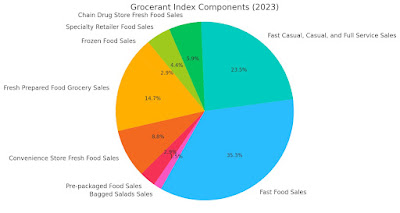In today’s food industry landscape, understanding family
size and changing demographics is key to capturing consumer dollars.
Restaurants, grocery stores, and convenience stores alike can unlock
significant revenue by tailoring offerings based on family configurations and
leveraging insights from the Steven Johnson Grocerant Guru® at Tacoma, WA
based Foodservice Solutions®, USDA, Mintel, IRI,
Technomic, and the U.S.
Census Bureau.
Family Dynamics Drive Dining Choices
The USDA's Food Away from Home division highlights that
families with children drive 40% of dining-out occasions. These families often
prioritize value, convenience, and menu customization. A Technomic report
reveals that 78% of parents seek out restaurants with bundled family meals,
reflecting a growing preference for cost-effectiveness and simplicity.
Conversely, households without children—a demographic now
accounting for over 40% of U.S. homes according to the U.S. Census
Bureau—frequently favor personalized, single-serving options. These consumers,
identified by Mintel as "solo diners," exhibit a higher tendency to
value premium ingredients and global flavors, often influencing the variety and
sophistication of grab-and-go meal options at grocery and convenience stores.
IRI’s 2023 Consumer Shifts Study indicates that Ready-2-Eat
(RTE) and Heat-n-Eat (HNE) solutions saw a 22% uptick in sales, driven by
smaller households and younger consumers looking for “made for me” meal kits
and portion sizes.
Census Bureau Insights: A Roadmap for
Businesses
The U.S. Census Bureau’s 7-year trend data reveals pivotal
demographic shifts:
·
Shrinking Household
Sizes: Average household size fell to 2.53
in 2023, down from 2.59 in 2016. Smaller households mean fewer large grocery
hauls and a preference for single-serving meal solutions.
·
Aging Population: Over 22% of U.S. households now include individuals aged
60 or older. This demographic increasingly favors meals with health-focused
options like low-sodium and plant-based choices.
·
Growth in
Multigenerational Households:
These homes—which rose by 17% in the last decade—prefer meal solutions that
cater to diverse dietary needs within one menu, such as mix-and-match entrée
kits or customizable dining bundles.
·
Diverse Ethnic
Composition: Asian and Hispanic populations, the
fastest-growing demographics, heavily influence flavor trends. Technomic’s
Flavor Consumer Trend Report indicates that 62% of consumers seek authentic
ethnic offerings, an opportunity for food operators to diversify their menus.
Actionable Strategies for Food
Operators
1. Restaurants:
Restaurants can cater to varied family sizes by offering
tiered menu bundles—for instance, options for families of three, four, or more.
Incorporating globally inspired RTE meal kits caters to smaller households,
while mix-and-match family-style dining resonates with multigenerational homes.
Mintel data emphasizes that visible family-focused promotions boost brand
relevance by up to 28%.
2. Grocery Stores:
Grocers should lean into scalable portioned meals.
Pre-portioned proteins and sides allow small households to curate their meals
while offering bulk bundles for larger families. IRI data underscores the
success of dynamic meal kits, showing a 35% growth in customizable offerings in
2023. Highlighting ethnic cuisines further attracts culturally diverse
shoppers.
3. Convenience Stores:
Convenience stores are uniquely positioned to capitalize on
grab-and-go family bundles, especially targeting late-night or sports-viewing
meals. Technomic found that 45% of consumers would purchase fresh-prepped
options from convenience stores if offered the same customization they expect
in restaurants.
Leveraging Food Facts for Success
The USDA’s Food Expenditure Series reveals that spending on
food away from home rose to 55% in 2022, compared to 44% in 2013. As the
population diversifies and household configurations evolve, operators must
align offerings with these changes:
1.
Flexibility is Key: From family-style meals to single-serve RTE items,
adaptability will dominate the next wave of food industry success.
2.
Market to
Multigenerational Needs: Highlight inclusive
packaging and menus that simplify meal planning for families with varying
dietary needs.
3.
Focus on Flavor
Trends: Global flavor authenticity and
healthier offerings appeal across demographic segments.
The Future Is Data-Driven
By combining USDA, Mintel, IRI, Technomic, and Census
Bureau insights, foodservice operators can strategically align their offerings
to the nuances of evolving family sizes and demographics. Understanding who is
buying, why they’re buying, and how they’re dining ensures enduring success in
this competitive market.
Are
you looking for a new partnership to drive sales? Are you ready for some fresh
ideations? Do your food marketing tactics look more like yesterday than
tomorrow? Visit GrocerantGuru.com for more information
or contact: Steve@FoodserviceSolutions.us Remember success
does leave clues and we just may have the clue you need to propel your
continued success.







No comments:
Post a Comment